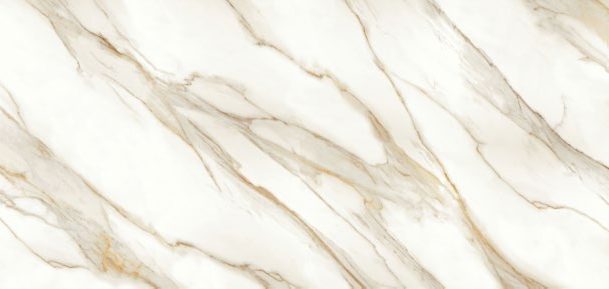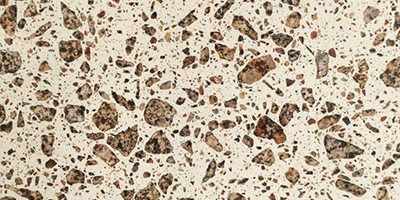Stone Slabs & Countertops
Premium Natural & Artificial Stone | 15+ Years Expertise | Global Exporter
A trusted leader in research, development, and production of high-quality artificial stone and natural stone slabs in South China with more than 15 Year expertise

Stone Slabs & Countertops
Premium Natural & Artificial Stone | 15+ Years Expertise | Global Exporter
A trusted leader in research, development, and production of high-quality artificial stone and natural stone slabs in South China with more than 15 Year expertise

Large-Scale Production Excellence
Harness Cutting-Edge Equipment & Technicque
Premium Solid Surfaces for 30+ Global Markets
From Value-Focused to Luxury Stone Slabs
Delivering premium solid surface materials to global markets more than 30 countries.
Products are ranging from economical types to high end luxury stone slabs.

One Million+ Sq.Ft. of Premium Stone Slabs in Stock Ready to Ship – Your Order, Your Choice
Choose from 100,000+ sqm of high-quality standard-design slabs for immediate delivery. Awarded by international stone slabs supplying unites worldwide.

Custom Countertops: Precision-Crafted to Your Designs
Our skilled craftsmen and engineers can bring any countertop vision to life - no design challenge is too complex for our team." Strive the be an excellent partner of cabinets manufacturers.
-
Profile
G-Stone
G-Stone is a leading artificial stone brand specializing in the production of solid surface slabs and advanced surface processing solutions.
Established in 2009, we relocated our headquarters to Guangzhou in 2016 to better serve our expanding customer base. Today, we operate three state-of-the-art production facilities in Yunfu, Foshan, and Dongguan, each dedicated to manufacturing quartz stone slabs, engineered granite slabs, and sintered stone slabs. Collectively, these facilities produce over 1 million square meters of premium materials annually, solidifying our position as a key player in the artificial stone industry.

-
What We Produce
Product
Premium Quality, Affordable Solutions for Global Markets
Supplying distributors, cabinet manufacturers, contractors, property owners, and developers worldwide:
- Quartz Stone: Timeless classics and modern designs, including nanolized solid surfaces and non-silica quartz slabs.
- Engineered Granite: Cost-effective yet stylish countertops and flooring with a variety of textures.
- Sintered Stone: Innovative designs and advanced equipment for diverse market needs.

-
Be Our Partner
Service
Exceptional Service Comparable to Your Own Factory – Satisfaction Guaranteed
- Custom Slab Pattern Design & Production: We specialize in creating unique slab patterns tailored to your needs or original natural stone sample, ensuring your products stand out in the market with unmatched originality.
- Massive Inventory Capacity: With over 100,000 square meters of artificial stone slabs in stock for regular models, we guarantee fast and efficient delivery to meet your deadlines.
- Advanced Countertop Processing: Our state-of-the-art production capabilities allow us to bring your most intricate countertop designs to life, precisely as you envision them.

G-Stone: Solve Your Stone Slabs & Countertops Frustrations
Designers | Cabinets Fabricators | Installers | Homeowners | Contractors & Builders | Real Estate Developers | Wholesalers
Stop battling with consistency, waste, surprises, cost, or care?
We see your granite, marble, quartz challenges daily. Explore the real headaches here and let`s solve them.

● Material Consistency: Variations in color/veining can disrupt design uniformity in cabinet projects.
● Workability: Hard stones (e.g., granite) increase tool wear; soft stones (e.g., marble) risk chipping during fabrication.
● Supply Chain Reliability: Delays in slab deliveries bottleneck production schedules.
● Cost Negotiation: Bulk discounts are critical for competitive pricing in high-volume orders.

● Schedule Risks: Late stone deliveries delay entire construction phases, incurring penalties.
● On-Site Adaptability: Slab dimensions/thickness must match blueprints to avoid re-cutting or returns.
● Labor Challenges: Heavy slabs require specialized equipment/crew, increasing labor costs.
● Durability Guarantees: Clients demand stain- and scratch-resistant materials to avoid post-installation complaints.

● Bulk Material Sourcing: Need cost-effective, high-volume suppliers for subdivision or multi-unit projects.
● Standardization: Consistent color/finish across all units (e.g., condo kitchens) is non-negotiable.
● Speed of Installation: Pre-cut or modular stone solutions speed up construction timelines.
● Warranty & Liability: Prefer suppliers who cover damage during installation or defects.
● Code Compliance: Materials must meet local regulations (e.g., fire ratings for high-rises).

● Decision Overwhelm: Confusion over stone types (e.g., quartz vs. marble) and long-term care.
● Budget Surprises: Hidden costs (e.g., seam placement, edge detailing) inflate quotes.
● Maintenance Anxiety: Fear of etching (marble) or heat damage (quartz) leads to analysis paralysis.
● Trust Gaps: Vetting suppliers for reliability (e.g., template-to-installation accuracy).

● Economies of Scale: Negotiating slab pricing for 100+ units impacts profit margins.
● Aesthetic Uniformity: Batch inconsistencies (e.g., quartz lots) risk buyer complaints in luxury projects.
● Turnkey Solutions: Prefer suppliers who handle fabrication/installation to streamline operations.
● Future-Proofing: High-traffic areas demand ultra-durable materials (e.g., sintered stone).

● Cash Flow Pressure: Slow-moving inventory (e.g., exotic marbles) ties up capital.
● Global Sourcing Risks: Geopolitical issues or shipping delays disrupt supply (e.g., Italian quarries).
● Trend Adaptation: Must pivot stock (e.g., rising demand for porcelain slabs) without overstocking.
● Damage Liability: Broken slabs in transit result in profit loss and client disputes.

● Vision Execution: Limited by slab sizes (e.g., unable to book-match small-format marble).
● Sample Logistics: Physical samples are heavy/costly to ship; digital tools may lack accuracy.
● Customization Delays: Complex cuts (e.g., angled islands) require longer lead times.
● Sustainability Demands: Clients seek recycled content or low-VOC adhesives for LEED certification.
Whether you’re a property owner seeking premium artificial stone materials, a real estate developer requiring bulk supply, or a designer looking for the perfect finish, we cater to your specific needs. Our solutions are equally valued by cabinet manufacturers crafting fine furniture, project contractors managing tight timelines,and wholesalers needing reliable stone slab inventory.
“Your Challenges, Our Commitment” We understand your pain points and the precision your project demands. Count on our full cooperation to deliver flawless execution – because your perfect finish is our mission.
Different Stone Slabs for Buyer`s Guide
We currently manufacture and supply the following types of stone slabs, which covers most the artificial stone materials used for countertops of interior and outdoor surface covering. In case you cannot find what you are looking for, don`t hesitate to send us a photo of your stone. More than half of our partners have started cooperation with us with a simple photo of stone texture.

Microcrystalline stone
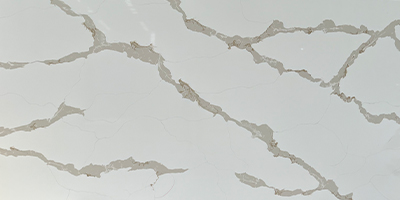
Free Silica Quartz Stone

Natural Marble Slabs
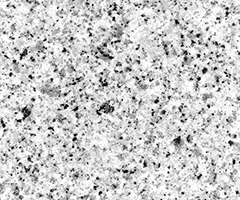
Natural Granite Slabs
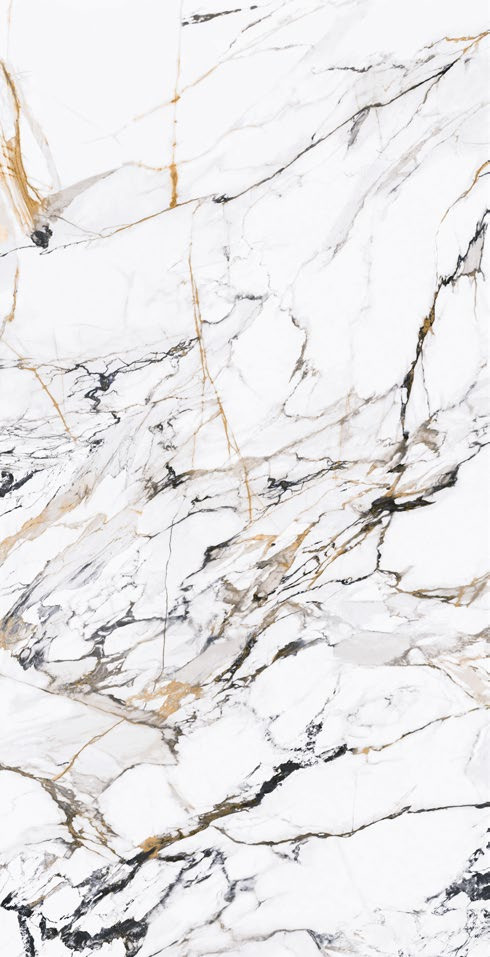
Sized Porcelain Slabs
The Countertops for Buyer`s Guide
Source premium granite, marble, & quartz slabs direct from us. Then we can further expertly fabricate them into custom countertops, vanities, cladding, and bespoke architectural elements – precisely cut, finished, and installed to your project’s demanding specifications. Streamline your supply chain with one reliable partner for raw stone & finished products.
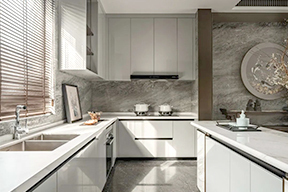


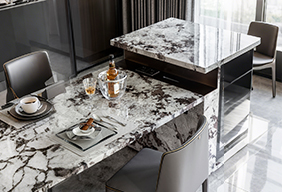
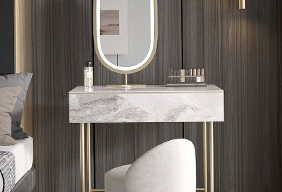
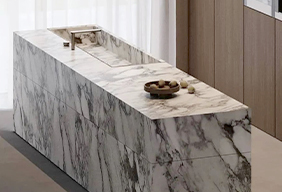

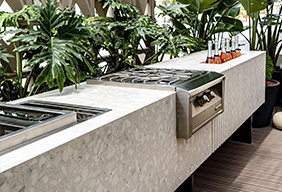
Stock for Sale
Skip the wait and accelerate your projects! Our extensive inventory of readily available natural stone slabs and artificial stone slabs eliminates long lead times. Partners gain immediate access to a vast selection, enabling faster order fulfillment, quicker installations, and seamless project flow. Leverage our stock for reliable timelines and enhanced responsiveness – your convenience is our priority. Partner with efficiency.
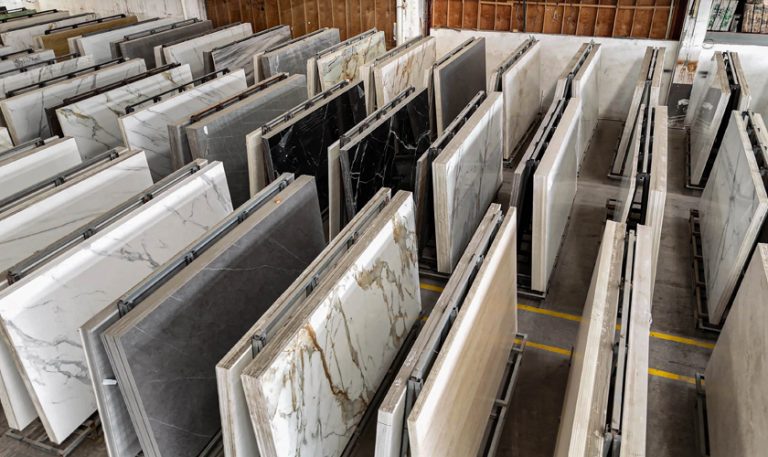
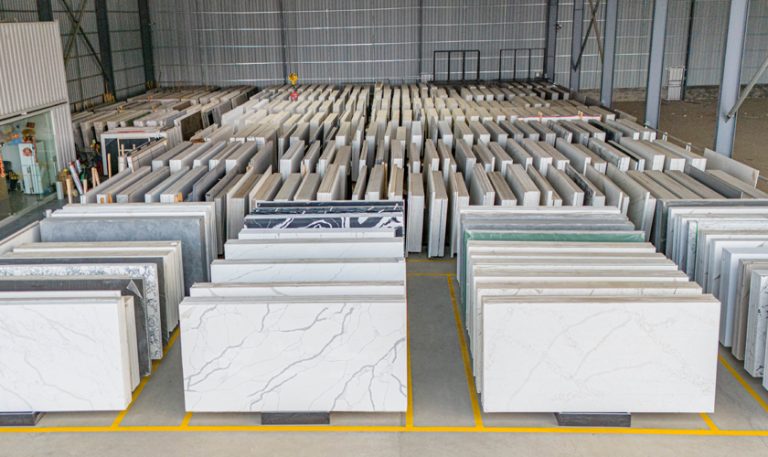


Stock For Sale
June 2025
● 10 USD Per/sqm Starting Price
● 100+ Models For Your Choice
● 100,000 Sqf Warehouse As Stock Area
●1,000,000 Sqf Stone Slabs Ready To Ship
Your Project Vision, Our Stone Solid Promise & Expertise
From First Photo to Final Installation!
Why Clients Love Working With Us for Stones
-
One Photo of Slab from You to Start – No complicated service process
-
End-to-End Management – We handle for you to door with all details
-
Transparent Updates – Know your project status
-
Stress-Free Results – Perfect countertops, guaranteed

Simply send us a photo of your stone or countertop project with sizes, and we’ll handle the rest: material selection, custom solutions, precise quoting, CAD drawings, and flawless delivery – all with white-glove service.
What Makes G-Stone Different From Others ?
We take pride in exceptional stone products and meticulous service. Our commitment to quality craftsmanship and durable materials shines through in every project. Don’t just take our word for it – explore the gallery below showcasing real installations. See firsthand how we transform spaces with premium stone and reliable solutions.

Stock Selection / Ready-to-Ship Slabs
Immediate availability from our inventory, reducing lead times for urgent projects (on-site photo)
Custom-Cut Slabs
Precision-cut to your specified dimensions, ensuring minimal material waste and perfectly fit. (stone parts are protected on red carpet)
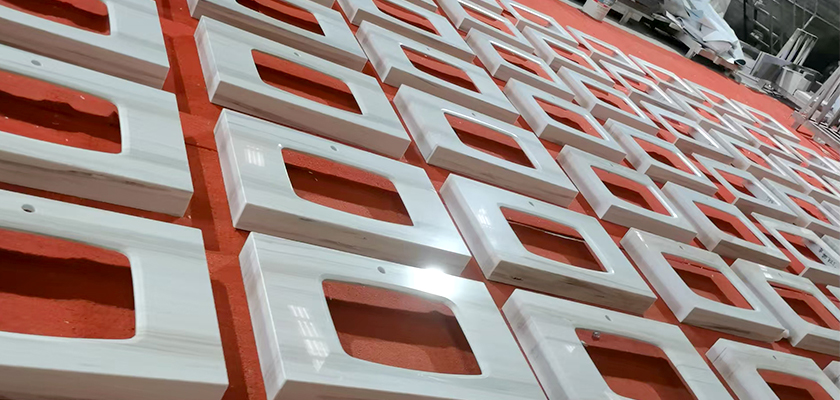
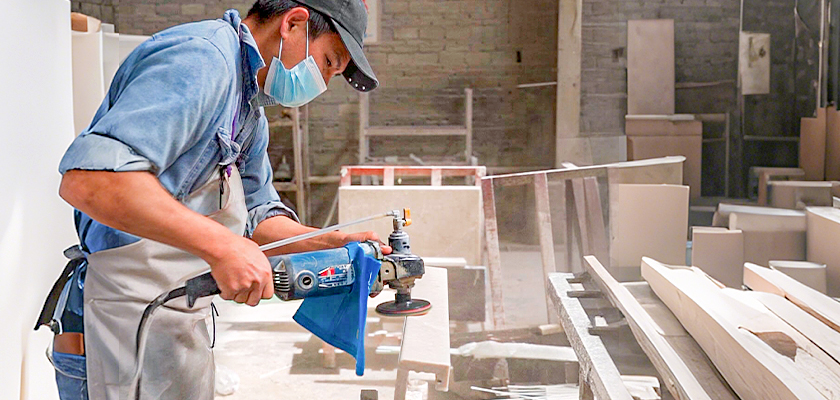
Project-Specific Fabrication
Tailored solutions for architectural or large-scale projects, from unique finishes to complex shapes (on-site photo)
Luxury Stone Customization
Exclusive access to high-end, rare stone varieties, crafted to bespoke design requirements.
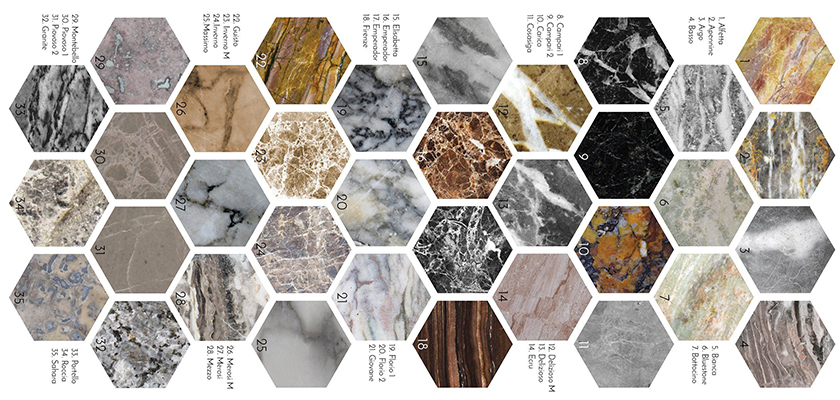
Domestic and Abroad Project Parnters
With dozens brands of world-famous developers, hotels, contractors, G-Stone treat seriously with each product that are delivered.





Real money talks, and when it comes to luxury interior design in Malaysia’s high-end villas and hotels, the choice of materials must balance aesthetics, durability, and cost-effectiveness. While natural stones like marble slab and granite have traditionally been popular, quartz stone slab has emerged as the superior choice for discerning property developers and designers. The fundamental advantage lies in quartz’s exceptional value proposition: it offers the luxurious appearance of high-end natural stone at a more accessible price point, while outperforming other materials in durability and maintenance requirements. Natural stones often prove impractical for Malaysia’s climate and high-traffic environments due to their porosity, susceptibility to staining, and demanding maintenance needs. Meanwhile, alternative materials simply cannot replicate the premium feel and sophistication that quartz delivers. This perfect balance of luxury aesthetics and practical benefits makes quartz stone the ideal solution for Malaysia’s luxury hospitality sector.
Introduction: The Rise of Quartz Stone in Malaysian Luxury Interiors
Malaysia’s hospitality and luxury real estate sectors have seen remarkable growth over the past decade. With an influx of tourists and a booming economy, properties like the St. Regis Kuala Lumpur and the Four Seasons Hotel Langkawi have set new standards in opulence and design. A key element in these transformations has been the strategic use of quartz stone in interiors. But why exactly is quartz stone becoming the go-to material for high-end villas and hotels in Malaysia? This blog delves into the reasons, backed by industry insights and case studies from Malaysia’s most prestigious properties.
1. Exceptional Durability and Strength for High-Traffic Areas
Quartz stone is renowned for its incredible durability, making it ideal for luxury villas and hotels that experience high foot traffic. Composed of approximately 90-95% natural quartz crystals and 5-10% polymer resins, quartz surfaces are non-porous, scratch-resistant, and highly resilient. In Malaysian hotels like The Ritz-Carlton, Kuala Lumpur, quartz countertops are used in kitchens, bathrooms, and common areas because they can withstand daily wear and tear without losing their luster. This durability translates to long-term cost savings, as replacements and repairs are minimized—a crucial factor for luxury properties aiming to maintain pristine conditions.
Moreover, quartz’s hardness (rated 7 on the Mohs scale) surpasses many natural stones, ensuring it remains intact even in bustling hotel lobbies or villa entrances. For instance, the St. Regis Kuala Lumpur incorporates quartz vanities in guest bathrooms, where durability is essential to handle frequent use by guests. This strength also makes quartz resistant to chipping and cracking, which is particularly valuable in Malaysia’s humid climate where temperature fluctuations can affect material integrity.
2. Aesthetic Versatility That Complements Luxury Design
One of the standout features of quartz stone is its aesthetic flexibility. Available in a wide range of colors, patterns, and finishes, quartz can mimic the look of natural stones like marble, granite, or onyx while offering superior performance. This versatility allows designers in Malaysia to create bespoke interiors that exude elegance and sophistication. For example, the Four Seasons Hotel Kuala Lumpur uses quartz surfaces in its suites and dining areas to achieve a seamless, modern look that appeals to discerning travelers. The ability to customize quartz—whether through veined patterns reminiscent of Carrara marble or solid hues for a minimalist vibe—makes it a favorite for luxury villas in destinations like Langkawi and Penang, where unique design statements are paramount.
In addition, quartz’s consistency in color and pattern ensures uniformity across large spaces, which is essential for hotels aiming for a cohesive aesthetic. This is evident in properties like the Mandarin Oriental, Kuala Lumpur, where quartz accents in lobbies and rooms create a harmonious flow. For villa owners, this means the material can be used throughout the property—from kitchen countertops to bathroom walls—without worrying about mismatched slabs.
3. Hygiene and Safety: A Non-Porous Surface for Cleanliness
In the post-pandemic era, hygiene has become a top priority for luxury accommodations. Quartz stone’s non-porous nature makes it inherently resistant to bacteria, mold, and stains, as it doesn’t absorb liquids or harbor germs. This is especially important in Malaysia’s tropical climate, where high humidity can promote microbial growth. Hotels like the Shangri-La Hotel Kuala Lumpur leverage quartz in bathrooms and kitchenettes to ensure a sanitary environment for guests. The ease of cleaning—requiring only mild soap and water—further enhances its appeal, reducing the need for harsh chemicals that could damage other surfaces.
Furthermore, quartz is certified by organizations like NSF International for food safety, making it suitable for kitchen countertops in luxury villas where gourmet cooking is common. This hygienic advantage not only protects guests but also aligns with the five-star standards that Malaysian hotels strive to uphold. For instance, the Banyan Tree Langkawi uses quartz in its villa kitchens to combine luxury with peace of mind, ensuring that every surface meets the highest health standards.
4. Low Maintenance and Ease of Care
Luxury properties in Malaysia demand materials that are both beautiful and practical, and quartz stone excels in low maintenance. Unlike natural stones such as marble or granite, quartz doesn’t require periodic sealing or special treatments to maintain its appearance. This is a significant advantage for busy hotels and villas, where time-efficient upkeep is essential. The St. Regis Kuala Lumpur, for example, uses quartz tabletops in its dining areas because they can be quickly wiped clean after each use, allowing staff to focus on other tasks.
Additionally, quartz’s resistance to stains from common substances like coffee, wine, or oils means that spills can be easily addressed without leaving permanent marks. This is crucial in villa settings, where homeowners entertain guests and host events. By choosing quartz, property managers in Malaysia reduce long-term maintenance costs while ensuring that interiors always look impeccable—a key selling point for luxury rentals and hotels competing in a crowded market.
5. Heat and Moisture Resistance for Malaysia's Climate
Malaysia’s hot and humid climate poses challenges for interior materials, but quartz stone is uniquely equipped to handle these conditions. Its composition makes it highly resistant to moisture, preventing warping or discoloration that can occur with wood or other surfaces. This is why hotels like the Majestic Hotel Kuala Lumpur incorporate quartz in bathrooms and outdoor-themed areas, where exposure to humidity is constant. Similarly, luxury villas in coastal regions such as Langkawi use quartz for outdoor kitchens and poolside bars, as it withstands sea air and rain without deteriorating.
Quartz also offers moderate heat resistance, though it’s advisable to use trivets for very hot items. This balance makes it suitable for Malaysian properties where indoor-outdoor living is popular. For example, the Datai Langkawi features quartz surfaces in its villas’ al fresco dining areas, blending durability with the natural beauty of the surroundings. By leveraging quartz’s climate adaptability, Malaysian luxury properties enhance both functionality and aesthetic appeal.
6. Cost-Effectiveness and Long-Term Value
While quartz stone may have a higher initial cost compared to some materials, its long-term value makes it a smart investment for luxury villas and hotels. The durability and low maintenance translate to reduced lifecycle costs, as quartz surfaces can last for decades with minimal care. In competitive markets like Malaysia’s hospitality industry, this cost-effectiveness allows properties to allocate resources to other amenities. The Four Seasons Resort Langkawi, for instance, uses quartz in its villas to achieve a luxury feel without exorbitant upkeep expenses, ultimately boosting profitability.
Moreover, quartz adds to the property’s resale or rental value by appealing to buyers and guests who prioritize quality and modern design. For villa developers in Malaysia, incorporating quartz into interiors can be a key differentiator in marketing materials, as seen in high-end projects like The RuMa Hotel and Residences in Kuala Lumpur. By choosing quartz, owners ensure that their investments remain attractive and functional for years to come.
7. Eco-Friendliness and Sustainability
As sustainability becomes a core concern in luxury design, quartz stone stands out for its eco-friendly attributes. Many quartz products use recycled materials and are manufactured with energy-efficient processes, reducing their environmental footprint. Brands like Caesarstone and Silestone, which are popular in Malaysia, adhere to green certifications, making them a responsible choice for properties aiming for LEED or other sustainability standards. Hotels like the EQ Kuala Lumpur have embraced quartz in their eco-conscious renovations, aligning with global trends toward green building.
In addition, quartz’s longevity means less frequent replacements, which minimizes waste. For luxury villas in Malaysia, this sustainability aspect can be a selling point for environmentally aware clients. By integrating quartz into their designs, properties contribute to a circular economy while maintaining a luxurious image—a win-win for both business and the planet.
Case Studies: Quartz Stone in Malaysian Luxury Properties
To illustrate these benefits, let’s examine how specific Malaysian hotels and villas have successfully incorporated quartz stone into their interiors:
- The St. Regis Kuala Lumpur: This five-star hotel uses quartz countertops in its guest suites and spa areas for their durability and elegant appearance. The material’s ability to resist stains and moisture has made it ideal for high-use spaces, enhancing the guest experience while reducing maintenance costs.
- Four Seasons Hotel Langkawi: In its luxury villas, quartz is featured in kitchens and bathrooms, where its non-porous surface ensures hygiene and its aesthetic versatility complements the resort’s natural surroundings. This has helped the property maintain its reputation for sophistication and comfort.
- The Ritz-Carlton, Kuala Lumpur: Known for its opulent design, this hotel utilizes quartz in lobby accents and restaurant tabletops. The stone’s heat and scratch resistance have proven invaluable in busy dining environments, while its sleek look adds to the overall luxury ambiance.
- Banyan Tree Langkawi: This resort incorporates quartz in its villa interiors to blend durability with tropical elegance. The material’s resistance to humidity has been particularly beneficial in Langkawi’s coastal climate, ensuring long-lasting beauty.
These examples demonstrate how quartz stone can elevate the design and functionality of luxury properties in Malaysia, making it a worthwhile investment for developers and owners alike.
Conclusion: Embrace Quartz Stone for Your Malaysian Luxury Property
In summary, quartz stone offers a compelling combination of durability, aesthetics, hygiene, low maintenance, climate resistance, cost-effectiveness, and sustainability that makes it ideal for luxury villas and hotels in Malaysia. As evidenced by leading properties like the St. Regis and Four Seasons, quartz can transform interiors into spaces that are both beautiful and practical. Whether you’re developing a new villa or renovating an existing hotel, consider integrating quartz stone to enhance your property’s appeal and value.
If you’re inspired to incorporate quartz stone into your project, visit www.china-countertop.com to explore our premium quartz products. Our team can help you select the perfect options for your needs, ensuring that your Malaysian property stands out in the competitive luxury market. Contact us today for a consultation!
Many ask: “Is custom stone a practical choice, or just a luxury for the elite?“
Walk into any stone supplier’s showroom, and you’ll see the same familiar quartz and granite slabs. They’re beautiful, but generic. What happens when your vision is constrained by their catalog, or your project demands something truly unique?
The truth is, for forward-thinking designers, builders, and retailers, custom quartz stone slabs are a strategic business decision, not an extravagance. It’s the key to solving real-world design, sourcing, and commercial challenges.
Here’s how deep customization is reshaping the industry, far beyond simple color choices.

1. The Art of Replication: Capture Any Look, Perfect It.
Imagine a client shows you a sample of a rare, extinct marble from a historic building. Or they love a pattern from a high-end brand, but it’s patented or out of stock.
This is where we excel.
We specialize in taking your sample—be it natural stone or an existing quartz slab—and replicating it with over 90% accuracy. But we don’t just copy; we optimize. We can strengthen weak veins, enhance color consistency, and create a more durable, harmonious version of the original.
Project Spotlight: The "Nova Hotel" Chain in China
Challenge: The Nova Hotel Group wanted a specific, veined Calacatta marble look for their bathroom vanities across 10 locations. The natural stone was too porous for high-traffic use, and the branded quartz they liked was patented.
Our Solution: We created a custom quartz stone that captured the exact veining and warmth of their reference sample. We even adjusted the pattern scale for a more dramatic effect on larger vanities. The result was a consistent, exclusive, and highly durable material that met their aesthetic and functional needs perfectly, all while navigating around patent restrictions.
2. Freedom from Standard Sizes: Your Vision, Uncompromised.
Why force your design to fit standard slab dimensions? Whether it’s an extra-long kitchen island, a seamless commercial reception desk, or a towering fireplace surround, physical constraints should not limit your creativity.
We provide complete physical dimension customization. Specify the exact length, width, and thickness you need. This eliminates unsightly seams, reduces material waste, and enables truly monolithic, breathtaking designs.
3. From Slab to Product: The Ultimate Customization.
The true power of custom stone is realized when you shape it into the final application. We don’t just supply the raw material; we help fabricate it into the centerpiece of your space.
- Custom Countertops: With unique edge profiles, integrated drainboards, or precisely cut openings.
- Custom Vessel Sinks: Create a stunning, one-of-a-kind custom vessel sink that becomes the bathroom’s focal point.
- Integrated Shower Systems: Fully custom-sized shower walls and basins for a flawless, minimalist wet room.
Project Spotlight: "Aura" Boutique in Thailand
Challenge: This high-end retailer needed a unique, sculptural custom vessel sink for their flagship store’s restroom—something no customer had ever seen before.
Our Solution: We worked with their designer to fabricate a freestanding sink from a single, flowing custom quartz stone slab. The organic shape and continuous, seamless surface became a talking point and perfectly embodied the store’s brand identity of exclusive luxury.
Why Your Business Needs Custom Stone
Choosing custom quartz stone isn’t just about aesthetics; it’s a smart business move:
- Navigate Patents: Create beautiful alternatives to patented designs from big brands.
- Product Exclusivity: Build your brand around products that can’t be found anywhere else.
- Perfect Project Fit: Ensure the material is technically and dimensionally perfect for the job, saving time and money on-site.
So, is it crazy to go custom? Only if you’re satisfied with the ordinary.
If your goal is to stand out, solve complex problems, and deliver unparalleled value to your clients, then custom stone slabs are your most powerful tool.
Ready to stop compromising and start creating?
Keywords & Expertise
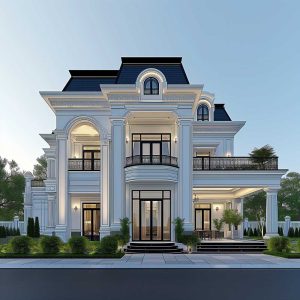
Why Luxury Villas and Hotels in Malaysia Are Embracing Quartz Stone in Interior Design
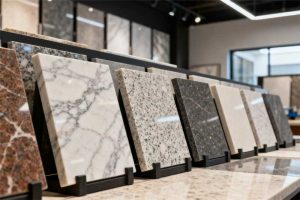
Beyond the Showroom: Why Custom Stone Slabs Are Your Secret Weapon
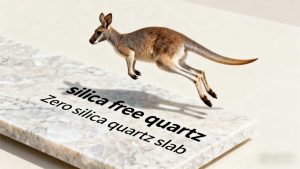
The Truth About Zero Silica Quartz: A Scientific Perspective
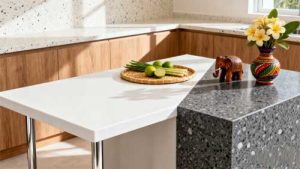
Southeast Asia’s Growing Preference for Quartz Countertops

Are Countertop Makers Shifting from Quartz to Sintered Stone?
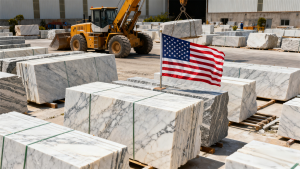
Trade War Impact on Chinese Stone Exports in 2025
Important Clarification: When manufacturers refer to “silica-free quartz” or use terms like “zero silica quartz” in marketing materials, they’re not claiming the complete absence of silicon dioxide. Instead, they’re referring to products formulated to eliminate or significantly reduce crystalline silica, which poses health risks when inhaled as dust during fabrication.

Australian Context
For Australian homeowners, builders, and architects seeking premium countertop materials, understanding the composition of quartz surfaces is crucial for making informed decisions that meet both aesthetic preferences and safety standards.
In the world of engineered stone surfaces, particularly in the quartz countertop industry, there’s a common misconception that needs addressing: the idea of “zero silica quartz.” As a technical marketing expert at G-STONE, a leading manufacturer of premium quartz surfaces, I frequently encounter this misunderstanding among both industry professionals and consumers.
Key Insight: Zero silica quartz does not exist in reality, but silica-free quartz does exist as a commercial product category with a specific meaning that differs from what many assume.
This blog post will explore the scientific and technical aspects of quartz composition, clarify the terminology confusion, and help you understand what “silica-free quartz” truly means in the context of engineered stone surfaces.
The Common Misconception
Many consumers and even some industry professionals mistakenly believe that “silica-free quartz” or “zero silica quartz” refers to a product that contains absolutely no silicon dioxide (SiO₂) – the chemical compound commonly known as silica. This misunderstanding can lead to incorrect assumptions about product safety, durability, and composition.
Important Clarification: When manufacturers refer to “silica-free quartz” or use terms like “zero silica quartz” in marketing materials, they’re not claiming the complete absence of silicon dioxide. Instead, they’re referring to products formulated to eliminate or significantly reduce crystalline silica, which poses health risks when inhaled as dust during fabrication.
This distinction is crucial for several reasons:
- It affects how we understand product safety during installation and fabrication
- It influences material selection for specific applications
- It impacts regulatory compliance in various markets, including Australia
- It determines appropriate handling procedures for fabricators
In the Australian market, where workplace health and safety standards are particularly stringent, understanding this distinction becomes even more important. The confusion between “zero silica” and “silica-free” terminology can lead to misinformed purchasing decisions and potentially unsafe handling practices.
Throughout this comprehensive guide, we’ll explore the chemistry behind quartz surfaces, the manufacturing processes that create “silica-free” alternatives, and what these terms truly mean for you as a consumer, designer, or fabricator.
The Science Behind Quartz Composition
To understand why “zero silica quartz” is a scientific impossibility, we need to explore the fundamental composition of quartz surfaces and the chemistry that makes them such durable and attractive materials for countertops and other applications.
What is Quartz, Chemically Speaking?
At its most basic level, quartz is a crystalline form of silicon dioxide (SiO₂). This mineral is one of the most abundant on Earth and forms the primary component of many natural stones, including granite and sandstone.
Silicon Dioxide (SiO₂)
Silicon dioxide, commonly known as silica, is a chemical compound consisting of one silicon atom bonded to two oxygen atoms. It appears naturally in several crystalline forms, with quartz being the most common and stable at room temperature.
Engineered quartz surfaces, such as those manufactured by G-STONE, typically contain:
- 90-95% natural quartz crystals – providing durability and the characteristic sparkle
- 5-10% polymer resins – binding the quartz particles together
- Pigments and additives – for color and special properties
Given this composition, it’s chemically impossible to create a “zero silica quartz” product while still maintaining the essential characteristics that define quartz surfaces. The very name “quartz” implies the presence of silicon dioxide.
The Health Concern: Crystalline Silica
The health concerns associated with quartz surfaces don’t stem from the material in its finished form, but from the dust generated during cutting, grinding, and polishing. When inhaled, fine particles of crystalline silica can pose serious respiratory health risks.
Australian Regulations
In Australia, Safe Work Australia has established strict workplace exposure standards for crystalline silica. The current workplace exposure standard for respirable crystalline silica is 0.05 mg/m³ averaged over an 8-hour workday.
This health concern has driven innovation in the industry, leading to the development of what are marketed as “silica-free quartz” or “zero silica quartz” products. However, these terms can be misleading without proper context.
What “Silica-Free Quartz” Really Means
When manufacturers refer to “silica-free quartz” or use similar terminology, they’re typically describing products where:
| Traditional Quartz | So-Called “Silica-Free Quartz” |
|---|---|
| Contains 90-95% crystalline silica | Replaces crystalline silica with alternative materials |
| Generates respirable crystalline silica dust when cut | Produces minimal or no respirable crystalline silica dust |
| Requires strict dust control measures during fabrication | May have reduced dust control requirements |
| Composition based primarily on natural quartz | Composition based on alternative minerals or manufactured materials |
These alternative materials might include:
- Recycled glass
- Porcelain and ceramic materials
- Other natural minerals with low silica content
- Advanced composite materials
Technical Note: Some “silica-free” products may still contain amorphous silica (non-crystalline forms) or small amounts of crystalline silica, but at levels low enough to meet regulatory thresholds for “silica-free” classification in certain markets.
The key distinction is that while these products dramatically reduce or eliminate the health risks associated with crystalline silica dust, they may not be completely free of silicon dioxide in all its forms.

The Manufacturing Process Difference
Traditional quartz manufacturing involves mixing natural quartz crystals with resins and pigments, then compressing and heating the mixture to form solid slabs. The high quartz content is what gives these surfaces their exceptional hardness and durability.
In contrast, “silica-free” alternatives use different base materials that provide similar physical properties without the high crystalline silica content. The manufacturing process may be similar, but the raw materials differ significantly.
At G-STONE, we’re transparent about the composition of all our products, including our range of lower-silica alternatives that meet the growing demand for safer fabrication options while maintaining the aesthetic and functional qualities that make quartz surfaces so popular.
Navigating the Market: A Guide for Consumers and Professionals
Understanding the distinction between marketing terminology and scientific reality is essential for making informed decisions in the quartz surface market. This final section provides practical guidance for consumers, designers, and fabricators navigating this complex landscape.
Why Terminology Matters
The confusion between “zero silica quartz” and “silica-free quartz” isn’t just semantic—it has real-world implications for:
- Health and safety compliance – particularly in regulated markets like Australia
- Product performance expectations – different compositions have different characteristics
- Installation and fabrication requirements – proper handling depends on accurate material knowledge
- Long-term durability and maintenance – material composition affects how surfaces age
Consumer Alert: Be wary of manufacturers or suppliers who claim their products contain “zero silica” while still marketing them as quartz surfaces. This is scientifically inaccurate and potentially misleading.
Questions to Ask Suppliers
When considering quartz surfaces or their alternatives, ask suppliers these key questions:
Essential Questions About Silica Content
- What is the exact crystalline silica content of this product?
- Has the product been tested by independent laboratories for respirable crystalline silica content?
- What safety data sheets (SDS) are available for this product?
- Does this product meet Australian standards for low-silica or silica-free classification?
- What alternative materials are used in place of crystalline silica?
- How do the physical properties compare to traditional quartz surfaces?
Reputable manufacturers like G-STONE will provide transparent, detailed information about product composition and safety data.
The Australian Market Context
In Australia, awareness of silicosis risks has grown significantly in recent years, leading to increased demand for safer alternatives to traditional quartz surfaces. Australian regulations now require strict dust control measures when working with materials containing crystalline silica.
For Australian consumers and professionals, this means:
- Increased scrutiny of material composition and safety data
- Growing preference for verified low-silica alternatives
- Higher expectations for manufacturer transparency
- Greater emphasis on proper fabrication practices regardless of material type
At G-STONE, we’ve responded to these market needs by developing products with reduced crystalline silica content while maintaining the aesthetic appeal and performance characteristics that make quartz surfaces so desirable.
Proper Handling of All Engineered Stone Products
Regardless of the silica content, proper safety measures should always be followed when fabricating any engineered stone product:
| Safety Measure | Importance |
|---|---|
| Water suppression systems | Reduces dust generation during cutting and grinding |
| Local exhaust ventilation | Captures dust at the source |
| Appropriate respiratory protection | Protects against inhalation of fine particles |
| Regular air monitoring | Ensures workplace exposure limits are not exceeded |
| Worker education and training | Ensures proper handling and awareness of risks |
Even with “silica-free” alternatives, these safety practices are recommended, as dust from any material can pose respiratory risks when inhaled in sufficient quantities.
Industry Best Practice: The most responsible approach is to treat all engineered stone products as potentially generating hazardous dust during fabrication, implementing appropriate controls regardless of the specific material composition.
The Future of Quartz and Alternative Surfaces
The engineered stone industry continues to evolve, with ongoing research into:
- New binding technologies that reduce or eliminate crystalline silica content
- Advanced composite materials with improved safety profiles
- More accurate and standardized testing methods for silica content
- Clearer industry terminology and classification systems
As these developments progress, transparency and accurate information will become even more critical for both manufacturers and consumers.
Distributors & Contractors in Australia
Conclusion
The distinction between “zero silica quartz” and “silica-free quartz” is more than just semantics—it’s about scientific accuracy, consumer transparency, and workplace safety. While truly “zero silica” quartz doesn’t exist, products with significantly reduced crystalline silica content are available and offer important safety benefits during fabrication.
As a consumer or professional in the Australian market, understanding this distinction empowers you to make informed decisions, ask the right questions, and implement appropriate safety measures regardless of the materials you choose.
At G-STONE, we’re committed to product innovation that doesn’t compromise on safety, quality, or transparency. We invite you to explore our range of quartz surfaces and alternative materials, all backed by detailed technical information and a commitment to excellence.
To Meet Your Need of Stone Easier
Whether you need premium stone solutions or want to explore possibilities, contact us today. We commit to excellence in every slab and service, ensuring your project delivers lasting beauty, value, and a seamless partnership. Your vision, perfected in stone.



